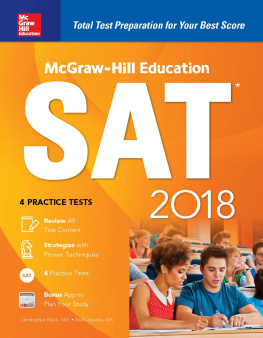Copyright 2016 by McGraw-Hill Education. All rights reserved. Except as permitted under the United States Copyright Act of 1976, no part of this publication may be reproduced or distributed in any form or by any means, or stored in a data base or retrieval system, without the prior written permission of the publisher.
ISBN: 978-1-25-958366-7
MHID: 1-25-958366-X
The material in this eBook also appears in the print version of this title: ISBN: 978-1-25-958407-7, MHID: 1-25-958407-0.
eBook conversion by codeMantra
Version 1.0
All trademarks are trademarks of their respective owners. Rather than put a trademark symbol after every occurrence of a trademarked name, we use names in an editorial fashion only, and to the benefit of the trademark owner, with no intention of infringement of the trademark. Where such designations appear in this book, they have been printed with initial caps.
McGraw-Hill Education eBooks are available at special quantity discounts to use as premiums and sales promotions or for use in corporate training programs. To contact a representative, please visit the Contact Us page at www.mhprofessional.com.
SAT is a registered trademark of the College Board, which was not involved in the production of, and does not endorse, this product.
TERMS OF USE
This is a copyrighted work and McGraw-Hill Education and its licensors reserve all rights in and to the work. Use of this work is subject to these terms. Except as permitted under the Copyright Act of 1976 and the right to store and retrieve one copy of the work, you may not decompile, disassemble, reverse engineer, reproduce, modify, create derivative works based upon, transmit, distribute, disseminate, sell, publish or sublicense the work or any part of it without McGraw-Hill Educations prior consent. You may use the work for your own noncommercial and personal use; any other use of the work is strictly prohibited. Your right to use the work may be terminated if you fail to comply with these terms.
THE WORK IS PROVIDED AS IS. McGRAW-HILL EDUCATION AND ITS LICENSORS MAKE NO GUARANTEES OR WARRANTIES AS TO THE ACCURACY, ADEQUACY OR COMPLETENESS OF OR RESULTS TO BE OBTAINED FROM USING THE WORK, INCLUDING ANY INFORMATION THAT CAN BE ACCESSED THROUGH THE WORK VIA HYPERLINK OR OTHERWISE, AND EXPRESSLY DISCLAIM ANY WARRANTY, EXPRESS OR IMPLIED, INCLUDING BUT NOT LIMITED TO IMPLIED WARRANTIES OF MERCHANTABILITY OR FITNESS FOR A PARTICULAR PURPOSE. McGraw-Hill Education and its licensors do not warrant or guarantee that the functions contained in the work will meet your requirements or that its operation will be uninterrupted or error free. Neither McGraw-Hill Education nor its licensors shall be liable to you or anyone else for any inaccuracy, error or omission, regardless of cause, in the work or for any damages resulting therefrom. McGraw-Hill Education has no responsibility for the content of any information accessed through the work. Under no circumstances shall McGraw-Hill Education and/or its licensors be liable for any indirect, incidental, special, punitive, consequential or similar damages that result from the use of or inability to use the work, even if any of them has been advised of the possibility of such damages. This limitation of liability shall apply to any claim or cause whatsoever whether such claim or cause arises in contract, tort or otherwise.
Welcome to
McGraw-Hill Education
Biology E/M
How to Use This Book
STUDYING SMART FOR THE SAT SUBJECT TESTS
S tudying hard is an important part of doing well in high school and beyond, and this book provides a comprehensive review of everything you need to know for the SAT Biology-E and Biology-M exams. But with a test that covers a large amount of material, as the Biology E/M test does, its important to use your studying time wiselya process we call studying smart.
Although ideally you would be able to study in depth all of the material presented in this book, we have designed this book with the understanding that you may not have enough time to review all of the material before your test date, and that you may need to spend more time reviewing certain areas of biology than others. This book is organized to allow you to study smart. It helps you:
 Identify the subject matter that needs more work
Identify the subject matter that needs more work
 Strengthen your ability to answer the types of questions that appear on the test
Strengthen your ability to answer the types of questions that appear on the test
 Focus your studying on the material thats most important for you
Focus your studying on the material thats most important for you
 Check your progress with questions at the end of each lesson
Check your progress with questions at the end of each lesson
 Practice your test-taking skills using sample tests
Practice your test-taking skills using sample tests
The following section explains how to use the features of this book to help you study smart and make the most of your preparation for the SAT Biology E/M test.
Step One: Identify Your Weaknesses
A crucial part of studying smart is knowing how much you need to study and knowing exactly what you need to study. The diagnostic test in should be your first step in identifying the areas that are most important for you to review before the SAT Biology test. You should take the diagnostic test and score it yourself. Be honestif you got a question right with a chance guess, then you can mark it right, but you may wish to circle it to indicate that you still might benefit from a review of the material covered in that question.
A detailed explanation of the answer to each question can be found at the end of the diagnostic test. Look for patterns in the question that youre getting wrong or that you had to guess. Are they all in one subject area, such as genetics? Is there one part of ecology that needs a brush up? The diagnostic test should tell you which sections of the book are most important for you to read before the test.
This book also contains, at the beginning of each section, a list of important vocabulary for that section. This vocabulary list provides an important way for you to gauge your ability; you should take some time to consider the words in each list, and ask yourself if you really know the definition and significance of each term. Make a list of sections that include terms with which you are unfamiliar or whose definition you struggle to remember. These sections should be on your list of sections to review before your test day.
Step Two: Strengthen Your Test-Taking Skills
One of the best ways to improve your performance on the SAT Biology test is to familiarize yourself with the most common types of questions asked on the test. The designers of the SAT Biology test dont design the exam randomly. In addition to asking questions that test your knowledge of biology, they specifically emphasize certain skills such as the ability to use collected data to form a conclusion (as one would in a biology lab), solve word problems, or use mathematical approximations such as Punnett squares or the HardyWeinberg equation (see ) to answer questions.
of this book teaches you how to answer types of questions that are specific to the SAT Biology exam. It will give you important tips on how to strengthen your test-taking skills before the test.
Step Three: Review the Material
This book provides a comprehensive review of all of the material in the five areas of biology covered on the Biology-E and Biology-M tests. Once you have identified the areas that you most need to focus on, you should review the relevant chapters or lessons.





 Identify the subject matter that needs more work
Identify the subject matter that needs more work